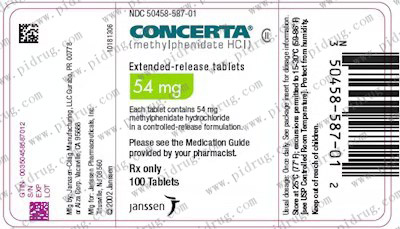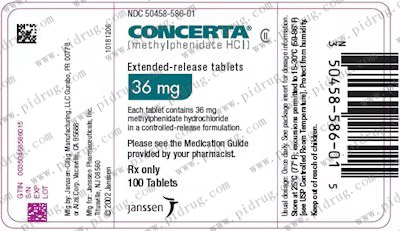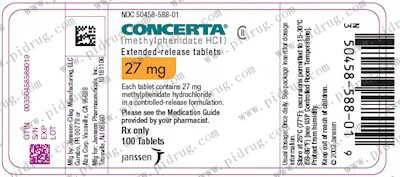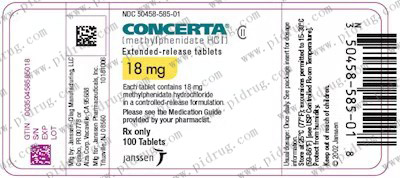6.罕见视觉障碍、视调节困难。
Concerta(Methylphenidate)
Methylphenidate, sold under the trade names Ritalin among others, is a stimulant medication used to treat attention deficit hyperactivity disorder (ADHD) and narcolepsy.[1] It is a first line medication for ADHD.[1] It is taken by mouth or applied to the skin.[1] Different formulations have different durations of effect.[1]
Common side effects include trouble sleeping, anxiety, and weight loss.[1] More serious side effects may include psychosis, allergic reactions, prolonged erection, abuse, and heart problems.[1] Methylphenidate is believed to work by improving the action of catecholaminesin the brain.[4] It achieves this by blocking dopamine and norepinephrine reuptake by neurons.[5][4] Methylphenidate is a central nervous system (CNS) stimulant of the phenethylamine and piperidine classes.[6][1]
Methylphenidate was first made in 1944 and was approved for medical use in the United States in 1955.[1][7] It was originally sold by CIBA, now Novartis Corporation.[7] It is estimated that in 2013 2.4 billion doses of methylphenidate were taken worldwide.[8] About 80% of this was taken by people in the United States making it the 47th most prescribed medication in that country.[8][9] It is available as a generic medication.[1] In the United States the wholesale cost of the immediate release formulation is less than US$0.30 per dose as of 2018.[10]
Medical uses
Methylphenidate is most commonly used to treat ADHD and narcolepsy.[11]
Attention deficit hyperactivity disorder
Methylphenidate is used for the treatment of attention deficit hyperactivity disorder.[12] The addition of behavioural modification therapy can have additional benefits on treatment outcome.[13][14] The dosage may vary and are titrated to effect.[15]
The short-term benefits and cost effectiveness of methylphenidate are well established.[16][17]A number of reviews have established the safety and effectiveness of the stimulants for individuals with ADHD over several years.[18][19][19][20] A 2018 review found that it may cause both serious and non-serious adverse effects in children and adolescents.[21] The precise magnitude of improvements in ADHD symptoms and quality of life that are produced by methylphenidate treatment remains uncertain as of November 2015.[22]
Approximately 70% of those who use these stimulants see improvements in ADHD symptoms.[23][24] Children with ADHD who use stimulant medications generally have better relationships with peers and family members,[18][23] generally perform better in school, are less distractible and impulsive, and have longer attention spans.[18][23] People with ADHD have an increased risk of substance use disorders, and stimulant medications reduce this risk.[25][26] Some studies suggest that since ADHD diagnosis is increasing significantly around the world, using the drug may cause more harm than good in some populations using methylphenidrate as a "study drug".[27] This applies to people who potentially may be experiencing a different issue and are misdiagnosed with ADHD.[27] People in this category can then experience negative side-effects of the drug which worsen their condition, and make it harder for them to receive adequate care as providers around them may believe the drugs are sufficient and the problem lies with the user.[27] Methylphenidate is not approved for children under six years of age.[28][29]
Narcolepsy
Narcolepsy, a chronic sleep disorder characterized by overwhelming daytime drowsiness and uncontrollable sleep, is treated primarily with stimulants. Methylphenidate is considered effective in increasing wakefulness, vigilance, and performance.[30] Methylphenidate improves measures of somnolence on standardized tests, such as the Multiple Sleep Latency Test (MSLT), but performance does not improve to levels comparable to healthy controls.[31]
Other medical uses
Methylphenidate may also be prescribed for off-label use in treatment-resistant cases of bipolar disorder and major depressive disorder.[32] It can also improve depression in several groups including stroke, cancer, and HIV-positive patients.[33] However, the use of stimulants such as methylphenidate in cases of treatment-resistant depression is controversial.[34]Stimulants may have fewer side-effects than tricyclic antidepressants in the elderly and medically ill.[35] In individuals with terminal cancer, methylphenidate can be used to counteract opioid-induced somnolence, to increase the analgesic effects of opioids, to treat depression, and to improve cognitive function.[36]
Enhancing performance
In 2015, review found that therapeutic doses of amphetamine and methylphenidate result in modest yet unambiguous improvements in cognition, including working memory, episodic memory, and inhibitory control, in normal healthy adults;[37][38] the cognition-enhancing effects of these drugs are known to occur through the indirect activation of both dopamine receptor D1 and adrenoceptor α2 in the prefrontal cortex.[37] Methylphenidate and other ADHD stimulants also improve task saliency and increase arousal.[39][40] Stimulants such as amphetamine and methylphenidate can improve performance on difficult and boring tasks[41][39][40] and are used by some students as a study and test-taking aid.[42][27] Based upon studies of self-reported illicit stimulant use, performance-enhancing use, rather than use as a recreational drug, is the primary reason that students use stimulants.[43]
Excessive doses of methylphenidate, above the therapeutic range, can interfere with working memory and cognitive control.[39][40] Like amphetamine and bupropion, methylphenidate increases stamina and endurance in humans primarily through reuptake inhibition of dopamine in the central nervous system.[44] Similar to the loss of cognitive enhancement when using large amounts, large doses of methylphenidate can induce side effects that impair athletic performance, such as rhabdomyolysis and hyperthermia.[45] While literature suggests it might improve cognition, most authors agree that using the drug recreationally as a study aid when ADHD diagnosis is not present does not actually improve GPA.[27]Moreover, it has been suggested that students who use the drug for studying may be self-medicating for potentially deeper underlying issues.[27]
Contraindications
Methylphenidate is contraindicated for individuals using monoamine oxidase inhibitors (e.g., phenelzine and tranylcypromine), or individuals with agitation, tics, or glaucoma, or a hypersensitivity to any ingredients contained in methylphenidate pharmaceuticals.[46]
The US FDA gives methylphenidate a pregnancy category of C, and women are advised to only use the drug if the benefits outweigh the potential risks.[47] Not enough animal and human studies have been conducted to conclusively demonstrate an effect of methylphenidate on fetal development. In 2007, empirical literature included 63 cases of prenatal exposure to methylphenidate across three empirical studies.[48]
Adverse effects
Methylphenidate is generally well tolerated.[50][51] The most commonly observed adverse effects with a frequency greater than placebo include appetite loss, dry mouth, anxiety/nervousness, nausea, and insomnia. Gastrointestinal adverse effects may include abdominal pain and weight loss. Nervous system adverse effects may include akathisia (agitation/restlessness), irritability, dyskinesia (tics), lethargy(drowsiness/fatigue), and dizziness. Cardiac adverse effects may include palpitations, changes in blood pressure and heart rate (typically mild), tachycardia (rapid resting heart rate), and Raynaud's phenomenon(reduced blood flow to the hands and feet).[52] Ophthalmologic adverse effects may include blurred vision and dry eyes, with less frequent reports of diplopia and mydriasis.[53] Other adverse effects may include depression, emotional lability, confusion, and bruxism. Hyperhidrosis (increased sweating) is common. Chest pain is rarely observed.[54]
There is some evidence of mild reductions in growth rate with prolonged treatment in children, but no causal relationship has been established and reductions do not appear to persist long-term.[55] Hypersensitivity(including skin rash, urticaria, and fever) is sometimes reported. The Daytrana patch has a much higher rate of dermal reactions than oral methylphenidate.[56]
Methylphenidate can worsen psychosis in psychotic patients, and in very rare cases it has been associated with the emergence of new psychotic symptoms.[57] It should be used with extreme caution in patients with bipolar disorder due to the potential induction of mania or hypomania.[58] There have been very rare reports of suicidal ideation, but evidence does not support a link.[55] Logorrhea is occasionally reported. Libido disorders, disorientation, and hallucinations are very rarely reported. Priapism is a very rare adverse event that can be potentially serious.[59]
USFDA-commissioned studies from 2011 indicate that in children, young adults, and adults there is no association between serious adverse cardiovascular events (sudden death, heart attack, and stroke) and the medical use of methylphenidate or other ADHD stimulants.[60]
Because some adverse effects may only emerge during chronic use of methylphenidate, a constant watch for adverse effects is recommended.[61]
Overdose
The symptoms of a moderate acute overdose on methylphenidate primarily arise from central nervous system overstimulation; these symptoms include: vomiting, agitation, tremors, hyperreflexia, muscle twitching, euphoria, confusion, hallucinations, delirium, hyperthermia, sweating, flushing, headache, tachycardia, heart palpitations, cardiac arrhythmias, hypertension, mydriasis, and dryness of mucous membranes.[45][62] A severe overdose may involve symptoms such as hyperpyrexia, sympathomimetic toxidrome, convulsions, paranoia, stereotypy (a repetitive movement disorder), rapid muscle breakdown, coma, and circulatory collapse.[45][62][63] A methylphenidate overdose is rarely fatal with appropriate care.[63] Severe toxic reactions involving abscess and necrosis have been reported following injection of methylphenidate tablets into an artery.[64]
Treatment of a methylphenidate overdose typically involves the application of benzodiazepines, with antipsychotics, α-adrenoceptor agonists, and propofol serving as second-line therapies.[63]
Biomolecular mechanisms
Methylphenidate has the potential to induce euphoria due to its pharmacodynamic effect (i.e., dopamine reuptake inhibition) in the brain's reward system.[71] At therapeutic doses, ADHD stimulants do not sufficiently activate the reward system, or the reward pathway in particular, to the extent necessary to cause persistent increases in ΔFosB gene expression in the D1-type medium spiny neurons of the nucleus accumbens;[68][71][78]consequently, when taken as directed in doses that are commonly prescribed for the treatment of ADHD, methylphenidate use lacks the capacity to cause an addiction.[68][71][78] However, when methylphenidate is used at sufficiently high recreational doses through a bioavailable route of administration (e.g., insufflation or intravenous administration), particularly for use of the drug as a euphoriant, ΔFosB accumulates in the nucleus accumbens.[68][71] Hence, like any other addictive drug, regular recreational use of methylphenidate at high doses eventually gives rise to ΔFosB overexpression in D1-type neurons which subsequently triggers a series of gene transcription-mediated signaling cascades that induce an addiction.[71][78][79]





